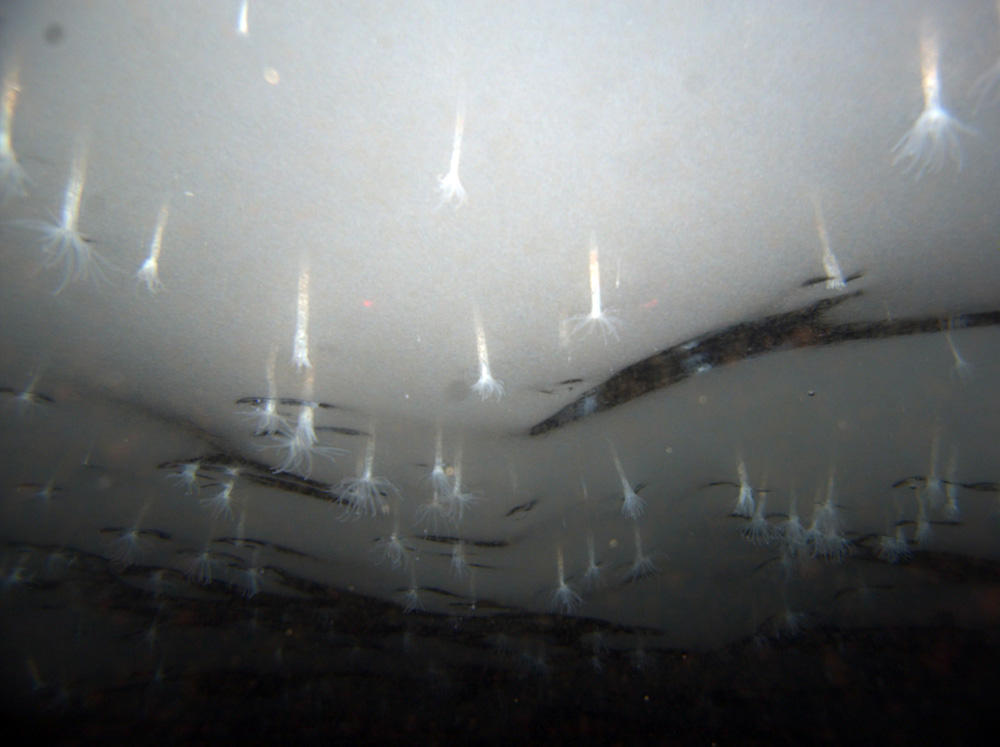|
In rare companyAntarctic sea anemone found under ice shelf one of top ten new speciesPosted June 6, 2014
A new species of sea anemone found living on the underside of an ice shelf in Antarctica was named by the International Institute for Species Exploration The new species, originally discovered in late December 2010, was publicly identified for the first time in an article published in December 2013 in PLOS ONE, an open-access, peer-reviewed journal published by the Public Library of Science. [See previous article — On the flip side: New species of sea anemone found underneath Ross Ice Shelf.] Though other sea anemones have been found in Antarctica, the newly discovered species is the first reported to live in ice. They also live upside down, hanging from the ice, compared to other sea anemones that live on or in the seafloor. The white anemones have been named Edwardsiella andrillae, in honor of ANDRILL Researchers with the ANDRILL program recovered more than two kilometers of sediments cores over the course of two field seasons during the previous decade. The sediment cores, like ice cores, can reveal details about past climate, as well as information about tectonic and geologic processes. [See previous article — That's a wrap: ANDRILL hits target depth for second straight year.] Photo Credit: Stacy Kim/Antarctic Photo Library
SCINI, a special robot built to operate under water in Antarctica, discovered the sea anemone under the Ross Ice Shelf.
The new species was discovered using a camera-equipped robot to survey the area under the Ross Ice Shelf as part of a pilot project to determine the feasibility to drill into the seafloor below. [See previous article — On the ice edge: ANDRILL gathers data to drill through moving ice shelf into ancient seafloor sediments.] Images of the new species showed small sea anemones burrowed into the ice, their tentacles protruding into frigid water like flowers from a ceiling. An international committee of taxonomists and related experts selected the top 10 In selecting Edwardsiella andrillae, the committee noted that its discovery “raises questions by its very existence. It is not clear how the species withstands the harsh conditions in its habitat.” The list includes a quartet of tiny newcomers to science: a miniscule skeleton shrimp from Santa Catalina Island in California; a single-celled protist that does a credible imitation of a sponge; a clean room microbe that could be a hazard during space travel; and a teensy fringed fairyfly named Tinkerbell. Also on the list are a gecko that fades into the background in its native Australia and a fungus that, conversely, blazed its way into contention by virtue of the bright orange color it displays when it’s produced in colonies. Rounding out the list are the first carnivore mammal to be described from the Western Hemisphere in 35 years; a 12-meter-tall tree that has been hiding in plain sight; and Zospeum tholussum, a tiny, translucent Croatian snail from one of Earth’s deepest cave systems. |



For USAP Participants |
For The Public |
For Researchers and EducatorsContact UsNational Science FoundationOffice of Polar Programs Geosciences Directorate 2415 Eisenhower Avenue, Suite W7100 Alexandria, VA 22314 Sign up for the NSF Office of Polar Programs newsletter and events. Feedback Form |


